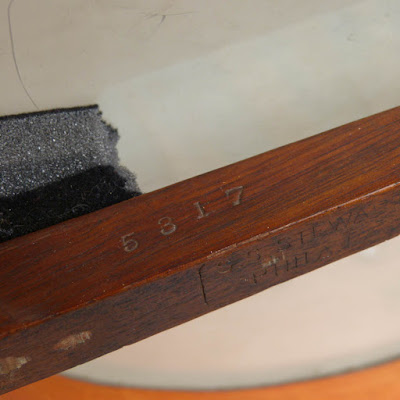1890 SS Stewart "The Amateur" 5-String Openback Banjo
This is a friend's old Stewart and she found it -- for free! -- at the dump. It came here, got a fret level/dress, much cleaning, replacement inlay and sprucing-up of chipped-out areas on the neck, a new bridge, strings, pegs, and a tailpiece. It had the Remo synthetic head on it when she scored it and so that was reused.
Real Stewarts (as in -- made at the Stewart factory rather than just branded Stewart) are among the most sought-after period banjos if you're into nylon/gut-strung old-time instruments. In their day they were arguably the most popular brand and even the lowest-grade models were built "tough and ready." This low-on-the-totem-pole "Amateur" model was available in A-scale (10" pot, shorter scale) sizes and this "standard" 11" rim size. This one also has a full, 27 1/8" scale length, too.
The sound is as you'd expect from a long-scale Stewart -- frontal, "tight" and focused, and with a good amount of volume. I almost always have to mute these instruments from behind the head just a tiny bit to cut down on overtones, however, because of this tonal signature.
The sound is as you'd expect from a long-scale Stewart -- frontal, "tight" and focused, and with a good amount of volume. I almost always have to mute these instruments from behind the head just a tiny bit to cut down on overtones, however, because of this tonal signature.
The neck and dowel are mahogany while the board, nut, and headstock veneer is all ebony. This was missing both its star inlays and I quickly filled them in with glue and bone dust to make an approxmation of a "vintage" repair... looks better than it sounds!
The idea was to just get this going as quickly and as inexpensively as possible.
I replaced a funky 5th-string "pip" with a bigger vintage screw, instead.
Note that the 5th peg is older but I've re-buttoned it with a new ivoroid button.
A new No-Knot tailpiece and NOS German maple "minstrel style" bridge finish the hardware allotment.
The rim has a mixed set of mostly antique hooks and nuts, though most of the shoes are original. I replaced 5 or 6 sets of both.
Since this is strung with nylon, all the pegs are friction units which work just fine.
I cut down the No-Knot hanger to keep it tidy.
At the heel I've replaced the missing neck brace (hammered-shim style which always loosens-up a couple times a year) with a simple bolted attachment. The owner of this instrument is a hard-playing rock-n-roll style lady and I figured function would be 100% more useful than form for her needs.
The dowel is marked "2nd grade" and note the cracked end of the dowel -- someone over-tightened! I like the cheesy old wired repair, though. It works.
#5317 corresponds to 1890.



















Comments